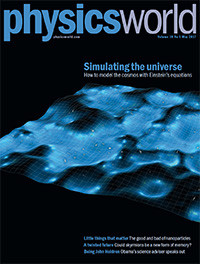 By Matin Durrani
By Matin Durrani
Einstein’s equations of general relativity might fit on a physicist’s coffee mug, but solving them is no mean feat. Now, however, the equations have been solved in a cosmological setting for the first time, as Tom Giblin, James Mertens and Glenn Starkman explain in the May 2017 issue of Physics World magazine, which is now live in the Physics World app for mobile and desktop
Elsewhere in the issue, you can enjoy an interview with John Holdren, who spent eight years as Barack Obama’s presidential science adviser. Find out too about the good and bad of nanoparticles and explore the potential that skyrmions – magnetic quasiparticles – could hold as a new form of memory storage.
Don’t miss either this month’s Lateral Thoughts, in which physicist Roger Todd describes how his invention of a system for automatically watering his house plants almost led to a commercial device.
Remember that if you are a member of the Institute of Physics, you can read Physics World magazine every month via our digital apps for iOS, Android and Web browsers.
For the record, here’s a run-down of what’s in the issue.
• Advice for Trump – Physicist John Holdren, who served as presidential science adviser and head of the Office of Science and Technology Policy during Barack Obama’s presidency, talks to Peter Gwynne about his expectations for the Trump administration’s approach to science and technology
• China forges ahead with Moon missions – With China about to send the first ever craft to the far side of the Moon, the country is quickly becoming a global leader in lunar exploration, as Ling Xin reports
• Entry denied Robert P Crease reports on a recent episode at the US border
• Dealing with the demand for teachers – Allison Barrett says that more physicists need to pass on their passion for physics by going into teaching
• Simulating the universe – Powerful computers are now allowing cosmologists to solve Einstein’s frighteningly complex equations of general relativity in a cosmological setting for the first time. Tom Giblin, James Mertens and Glenn Starkman describe how this new era of simulations could transform our understanding of the universe
• Little things that matter – Sidney Perkowitz explores the good and the bad of nanoparticles, from their positive medical applications such as photo-activated drug delivery, to their negative health and environmental effects
• Skyrmions: a twisted future – Kirsten von Bergmann and André Kubetzka explain the nature of a type of quasiparticle known as a magnetic skyrmion, which looks promising as a “bit” for future data-storage technology
• Search for the ‘perfect’ theory – Peter Woit reviews Theories of Everything: Ideas
in Profile by Frank Close
• The one scale that rules them all – Jennifer Ouellette reviews Scale: the Universal Laws of Life and Death in Organisms, Cities and Companies by Geoffrey West
• How to become an “edupreneur” – Setting up shop as a science communicator after getting your degree in physics is a tempting offer, especially for those who are interested in creating educational outreach materials, as Alaina G Levine finds out
• Once a physicist – Meet Libby Heaney: artist, researcher and lecturer. She works at the intersection of art, science and technology
• Of plants and pumps – Roger Todd on how his system for automatically watering his house plants almost led to a commercial device
Guidelines
Show/hide formatting guidelines
this text was deletedwhere people live in harmony with nature and animals</q>
Some text